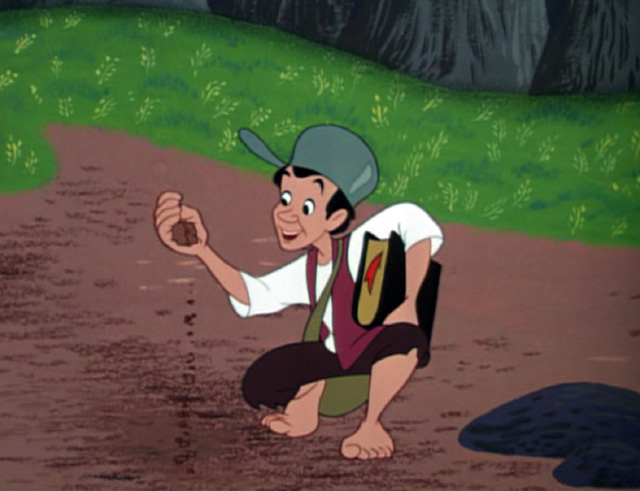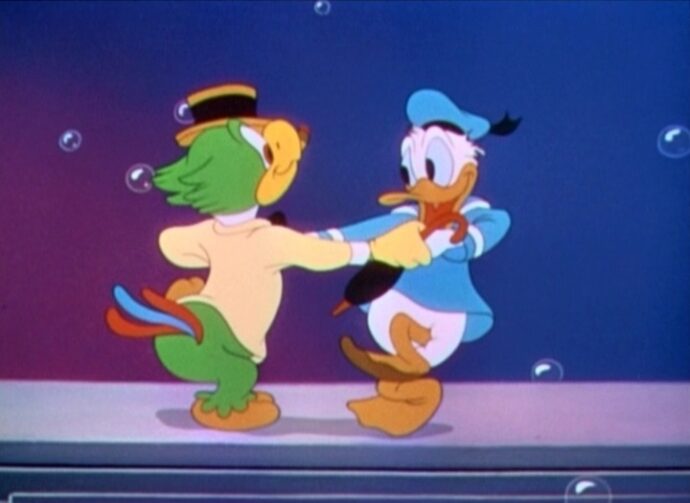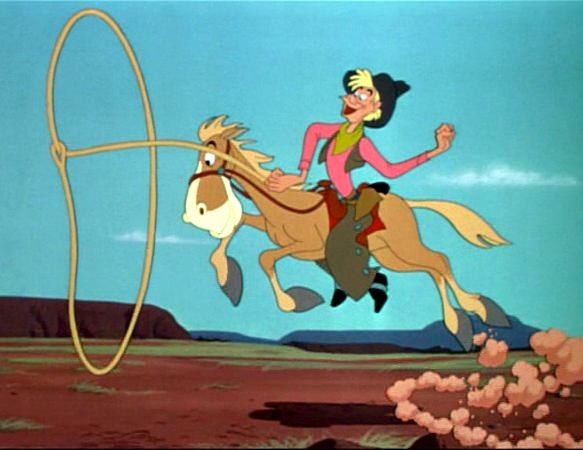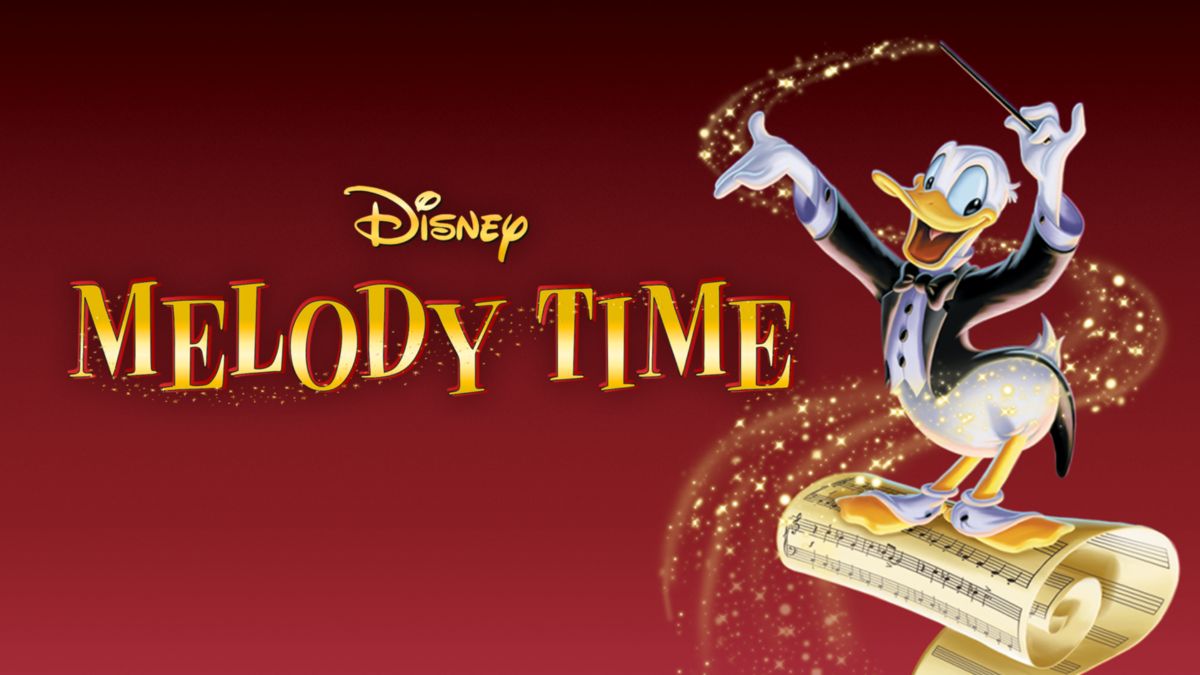Plus or Minus is a series detailing and analyzing every feature film now streaming on Disney+. It combines the unique history all these films share, their cultural impacts, and their qualities, or lack thereof. From timeless classics, to acquired hits, to DCOMs, no stone will be left unturned.
We continue the era of package films here at Plus or Minus with Melody Time. As said in my previous review for Fun and Fancy Free, Disney after World War II was on shaky ground. Animators left to fight for the war, while the remaining team worked on propaganda pieces. Their resources were exhausted, so the only thing they could do were package films. Produce a few cheaply-made shorts, and when enough were made, cram them into an hour-long feature. Melody Time was one of those movies.
The main theme that connects all the segments is music. More specifically, popular music and folk music performed by contemporary artists. Combining cheap animation with hit music acts, this was an easy way for Disney to make a little extra coin before returning to narrative features. But looking past its existence as a blatant cash grab, does this hold up in a modern lens? Like I’ve done before, it’s best to look at each segment as its own piece.
Once Upon a Wintertime
Frances Langford sings the title song, with the main plot being two young lovers enjoying a winter December day. And while there’s an incident with a frozen pond, they still find themselves on a heartfelt date. This is intertwined by two cute rabbits on a date as well.
It’s certainly sweet, and the art direction really pops here. There’s little in terms of outlines, giving this a unique storybook look. But it’s just not that compelling. There’s little conflict until the very end of the short, and even then it resolves itself pretty quickly. And while I like the visuals, it can only carry so much.
Bumble Boogie
The most surreal segment of the bunch, this short features a swing-jazz variant of Rimsky-Korsakov’s Flight of the Bumblebee. A bumble bee finds himself trying to literally survive the song, as a frenzy of music-themed imagery tries to attack him. It’s certainly an interesting segment. If anything, the vivid colors and utilization of classic music, albeit modernized, evokes aspects of Fantasia. But at the same time, it feels a bit too short. By the time things start going in an insane and exciting direction, it just stops. It’s an unfortunate conclusion that leaves you wanting more.
And…there’s not much else left to add here. Again, kind of disappointing.
The Legend of Johnny Appleseed
The most straightforward story of the bunch, this is a nice little retelling of the Johnny Appleseed story. A pioneer who plants apple trees across the Midwest and spreads the Holy word of Christianity, this shows how Johnny brought bountiful treats to the country.
At 17 minutes, this is far and away the best segment of the film. It’s definitely corny and full of awkward moments. But it’s a sincere and sweet kind of corny that pulls the thing through. Johnny is a likable presence, helped by Dennis Day’s vocal performance, and there’s really great imagery and visuals on display. The backgrounds are especially great, giving the segment weight and realism. There’s even a few background images that are drop-dead gorgeous. The shot of the apple trees turning into the clouds in the sky is truly something to behold and is a perfect example of the talents many Disney animators took into each project.
And with the perfect length, it’s a very strong midpoint for this anthology and a lively short all on its own.

Little Toot
First of all, that is a very funny title. Secondly, the premise here is a troublemaking little steamboat who wants to be like his dad, but can’t seem to figure out how to behave. But as luck would have it, only Little Toot’s ingenuity can save the day. This certainly has some funny gags, and the narration, sung by The Andrews Sisters, is really soothing on the ears.
But it’s a pretty forgettable story and even with its short length, there’s no real reason to invest in Little Toot’s story. It’s in one ear, out the other, and then it’s on to the next segment. That’s kind of a running theme here in case you can’t tell.
Trees
The music here is not technically a song. Rather, a recitation of the 1913 poem “Trees” by Joyce Kilmer, performed by Fred Waring and the Pennsylvanians. The segment talks about trees, and showcases the changing of the seasons around this tree…and that’s it. There’s no real plot to speak of, it’s more just showcasing the beauty of nature.
There’s value here, as the pastel imagery is gorgeous to watch. It’s actually innovative, as the look was never seen before in animation. But the problem is that the subject matter isn’t interesting. It’s just about a tree. And while the poem isn’t bad, that doesn’t necessarily mean it translates into an interesting and compelling short.
It may be a touch fun to see Disney animators salvage the idea and bring needed beauty, but it doesn’t go far enough.
Blame it on the Samba
The appearance of Donald Duck on the Disney+ thumbnail and several VHS and DVD copies would have you believe he’s the star of this film. And sure enough, Donald does actually appear near the end in his own segment. Him and Jose Carioca, who appeared in two other package titles, are literally blue. And thus, the Aracuan Bird, another figure from The Three Caballeros, introduces the two birds to the joys of the samba.
Similar to Three Caballeros, there’s a lot of fun Latin music and colorful visuals. It’s not quite as daring or bold as Caballeros, but I can’t resist seeing all the unique colors and dances on display here. And if there’s anything the package films have made me appreciate, it’s Jose Carioca. His personality and animation really is fun to watch, and I’m always glad to see him pop up.
Definitely one of the stronger pieces.

Pecos Bill
This one has a pretty odd framing device, as it’s introduced in a live-action segment with Song of the South stars Bobby Driscoll and Luana Patten, alongside the band Sons of the Pioneers. It’s the story of Pecos Bill. A baby raised by coyotes who soon becomes the greatest cowboy who has ever lived. After a few heroic deeds, he soon finds love with a woman named Slue-Foot Sue, who herself finds herself in a comedic situation.
This is the longest segment of the piece, eclipsing 22 minutes of the film’s runtime. And while it is funny and well-animated, I don’t know if I think this was the best one to end on. It’s not especially memorable or hilarious. I’d argue at points it’s a little too goofy. And the short’s ending in particular is an odd one. It’s not really a happy or sad ending, and it’s not really melancholy or bittersweet. It just kind of ends on a weird fairy tale style note, and then the movie itself ends. Honestly kind of fitting for this movie.

Plus or Minus?
If there’s anything that’s come from watching these package films, it’s this odd sense of obligation. Obligation due to sitting through these movies, but also obligation on the animators. Movies like this and Fun and Fancy Free were made just to get some extra cash before they could make movies that were actually interesting. And it really shows.
Melody Time isn’t the worst. There’s fun segments in there, and it’s clear how much talent there is with Disney’s batch of animators. But outside of a few moments, there’s nothing that feels highly memorable or highly cinematic. It’s in one ear and out the other. This era has always been one that Disney fans have ignored, and it’s easy to see why.
Choosing Plus or Minus for Melody Time was somewhat easy here: it’s an easy Minus.
NEXT TIME: The package era ends with The Adventures of Ichabod and Mr. Toad. Are these two segments good enough to salvage this forgotten era of Disney?
